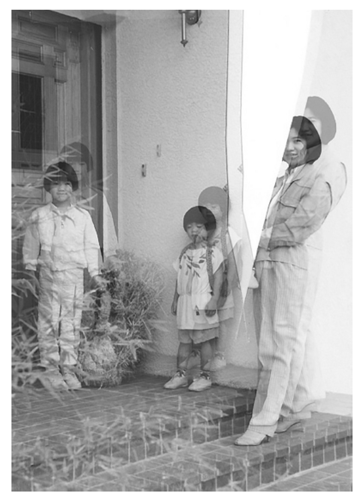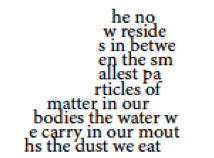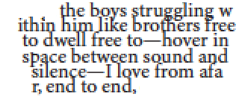An Argument for Counter-Monument Poetics—Part 2

Intimate Shapes—Diana Khoi Nguyen
In her anthology Against Forgetting: Twentieth-Century Poetry of Witness, Carolyn Forché describes her rubric for marshalling these works together: these are “poets who endured conditions of historical and societal extremity during the twentieth century,” she explains. Forché goes on to define this as “exile, state censorship, political persecution, house arrest, torture, imprisonment, military occupation, warfare, and assassination.” I hope, in this portion of an essay and its predecessor, to take this definition and allow it a more liberal approach—consider “historical and societal extremity” via experiences that are harder to pin down. What of exile within your own country due to your identity? What tortures do you endure when you discover traumas of your ancestors redacted from the archive? What of state censorship of the self? Political persecution? Psychological and emotional tyranny are arguably just as damaging as their physical counterparts. This is not to imply the explicit physical oppression and the poetry out of that is no longer urgent or interesting, or to diminish the importance of Forché’s work. Instead, in the spirit of Claudia Rankine’s efforts, Toi Derricotte’s, others, that point to the impact of cultural hegemony in subjective terms, I want to peer more deeply into the minutiae of quieter social oppression and writers’ attempts to build counter-monuments through writing of witness. Monuments are important for Forché, too, as she writes the anthology is “a poetic memorial to those who suffered and resisted through poetry itself.” Each of the poets documenting the reality of their experiences while their nation-states proffer more palatable alternatives to the public—those which preserve their power and ability to maintain the dynamic that continues to serve that power. Yet who has power over whom, who constructs one’s narrative, is not always so simple.
Diana Khoi Nguyen’s first collection of poetry, Ghost Of, engages with monuments that narratives of familial tragedy erect. Nguyen’s younger brother committed suicide which, unsurprisingly, according to the book, determined a great deal for her family. In the collection Nguyen combs through her childhood, searching for clues for her brother’s isolation that led to his death. Strikingly, Nguyen includes family photographs from which her brother had, at times with great precision, cut himself out. He had apparently done this to many, if not all, the photos in their family home. The monument of family as maintained in the photographs, its narrative, was one he apparently could not contend with. He attempted to practice an excision while leaving the remainder intact. Yet, of course, that is impossible. The photographs become something else entirely—ephemera documenting his removal. Through concrete poetry (or poems that hold a specific shape to affect their meaning), Nguyen builds poetic counter-monuments to these altered family photos. The photographs themselves include a shadow duplicate behind itself, a kind of echo or ghost image, disorienting the eye, forcing you to lean in for a closer look to process the picture, its forms, the missing boy—but also blurring the identities of those who remain.
As poet Athena Farrokhzad writes, quoting her mother, “All families have their stories / but for them to emerge requires someone / with a particular will to disfigure.” While not exactly disfiguring, Nguyen’s engagement with the material of family involves a reshaping, or an investigation of the shapes trauma takes. She fills the excised contours with words regarding the person who took up that space in the photograph—her brother. Terrance Hayes writes of the book, “The parts cut from the narrative become song while the remaining narrative becomes fragmented, half-remembered,” which is indeed defined by the fragments Nguyen’s brother left behind. The following pieces consider the experiences of the family and loss, recognizing the brother’s act, the monument he altered by removing himself prior to suicide from these photographs, and builds something alongside it. The violence of that loss, what the photographs invariably signify, a means to build the counter-monument through poetics. The stalactite-shaped text in “Triptych” captures a feeling of dispersal, loss of memory, even losing the need of memory:
Transmutation is a process that is endless, from sugar to the bees that carry it away in innumerable particles, ashes scattered in water.
And water is a recurring theme for Nguyen. The poem “Gyotaku” references an 1800s Japanese tradition of applying paint to a caught fish and laying it on thin paper in order to transfer an accurate portrait of the fish’s body. Here, Nguyen takes a photograph from which her brother removed himself with a careful blade. He hovers as a concrete poem above the family. Nguyen writes,
The physical remnants of her brother, no matter how small, are still in the home. Microscopic reminders of the reality of their loss, hovering inside them. The next poem reproduces a copy of the same concrete piece set in her brother’s name repeated, looking like a sea of “Oliver”s (his name). As with conventional gyotaku, his body is one in water. Gyotaku was traditionally a piece of art, but also a record—it was how fishermen accounted for the size of their catch.
The implication here is that the soul disperses but returns elsewhere, continues its course alternatively. The living and dying constant and cyclical, yet existence enduring.
The penultimate poem of the collection, “Coda,” illuminates this concept further. Two concrete poems in the shape of the excised brother rest near each other. The one on the left illustrates the transmutative properties of water as with the soul in the vessel of a body. Nguyen writes,
Here she pours herself in the shapes of her brother, tries to place her words—herself—in him when embodied. To consider what he so deeply wanted to erase, why he wanted to erase it.
The final poem, also called “Triptych,” shows a three-piece picture frame with a young Nguyen in one frame, her younger sister in another, and an empty space we can assume once housed an image of their brother. As with the others, there is an echo image overlapping, here placing Nguyen and her sister together. The next page is a concrete poem filling the void of her brother’s empty frame. At one point, Nguyen writes,
Here, a quiet belief in the brother as water evaporated, out of bodily form, “free to—hover.” Not simply as a ghost or absence, but liberated. The last portion of “Triptych,” and the book, involves words in the shape of the frame and images of Nguyen and her sister, a final response to her brother’s excision from the monuments to family—his death. She writes, “there are two sides to the threshold / and many ways of crossing,” reiterating her consistent references to bridges, the building of them to access her brother though he is gone. This is an endless pursuit, as illustrated in the book’s ending:
***
The violence of loss, silence, here is not the final act of dialogue with Nguyen’s brother. This is because of her work. While he built an original monument to his isolation, Nguyen engages with it directly through her poems. Here she investigates the shapes left behind, the shapes missing. Pouring her words into shapes as one might pour water, seeing what those shapes proffer beyond absence. While her brother is missing from one aspect of life, the physical world, that does not indicate he does not exist—in ghost, heart, imagination, memory, and beyond.
Nguyen’s work felt important to consider in the world of counter-monument poetics for a few reasons. First, to illustrate one need not reach far back into history, the archive, or literature to enact this work. And second, though most who experience suicide or any loss of a loved one do experience anger, this isn’t a counter-monument written in spite of the monument that inspired it, but one written with the explicit aim of tenderness. As Nguyen writes, “you are part of / the whole and all around it.”
Diana Arterian is the author of the poetry collection Playing Monster :: Seiche (1913 Press, 2017), ...
Read Full Biography









